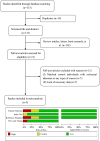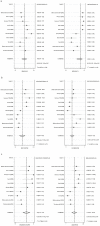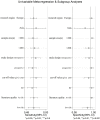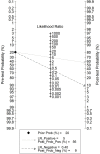TIMP-1 is a novel serum biomarker for the diagnosis of colorectal cancer: A meta-analysis
- PMID: 30458003
- PMCID: PMC6245680
- DOI: 10.1371/journal.pone.0207039
TIMP-1 is a novel serum biomarker for the diagnosis of colorectal cancer: A meta-analysis
Abstract
Purpose: Tissue inhibitor of metalloproteinase-1 (TIMP-1) is a glycoprotein involved in cell survival and tumorigenesis. There have been some promising results regarding the diagnostic value of TIMP-1 for patients with colorectal cancer (CRC). The aim of the present study was to assess the diagnostic accuracy and clinical utility of serum TIMP-1 in CRC patients through meta-analysis.
Methods: A systematic search of online databases was performed to collect eligible studies. The pooled sensitivity, specificity, diagnostic odds ratio (DOR), and summary receiver operator characteristic (SROC) curve were generated from accuracy data using the random-effects model. Fagan's nomogram and the likelihood matrix were applied to estimate the clinical utility of TIMP-1.
Results: A total of 9 eligible studies with 1886 patients were included. Among the patients, 819 were pathologically diagnosed with CRC, whereas 1067 did not have adenomas or other cancers. The overall sensitivity, specificity, and DOR of TIMP-1 for the diagnosis of CRC were 0.65 (95% confidence interval (CI): 0.57-0.72), 0.87 (95% CI: 0.76-0.94), and 12.73 (95% CI 5.71-28.38), respectively. The area under the SROC was 0.77 (95% CI, 0.73-0.81), suggesting the potential diagnostic value of TIMP-1 in CRC patients. Among patients with a pretest CRC probability of 20%, posttest probabilities were 56% and 9% for positive and negative TIMP-1 results, respectively.
Conclusions: TIMP-1 expression exhibits an upper moderate diagnostic value in CRC, and TIMP-1 assessment may be useful as a noninvasive screening tool for CRC in clinical practice.
Conflict of interest statement
The authors have declared that no competing interests exist.
Figures







Similar articles
-
Serum matrix metalloproteinase-9 level as a biomarker for colorectal cancer: a diagnostic meta-analysis.Biomark Med. 2018 Apr;12(4):393-402. doi: 10.2217/bmm-2017-0206. Epub 2018 Mar 26. Biomark Med. 2018. PMID: 29575908
-
Detection of microRNA-21 expression as a potential screening biomarker for colorectal cancer: a meta-analysis.Asian Pac J Cancer Prev. 2014;15(18):7583-8. doi: 10.7314/apjcp.2014.15.18.7583. Asian Pac J Cancer Prev. 2014. PMID: 25292032
-
Plasma TIMP-1 and CEA as Markers for Detection of Primary Colorectal Cancer: A Prospective Validation Study Including Symptomatic and Non-symptomatic Individuals.Anticancer Res. 2015 Sep;35(9):4935-41. Anticancer Res. 2015. PMID: 26254391
-
Diagnostic value of circulating miR-21 for colorectal cancer: a meta-analysis.Cancer Biomark. 2015;15(1):47-56. doi: 10.3233/CBM-140437. Cancer Biomark. 2015. PMID: 25524942 Review.
-
The value of microRNAs as the novel biomarkers for colorectal cancer diagnosis: A meta-analysis.Pathol Res Pract. 2020 Oct;216(10):153130. doi: 10.1016/j.prp.2020.153130. Epub 2020 Jul 19. Pathol Res Pract. 2020. PMID: 32853954 Review.
Cited by
-
Anti-Tumor Activity of Orally Administered Gefitinib-Loaded Nanosized Cubosomes against Colon Cancer.Pharmaceutics. 2023 Feb 17;15(2):680. doi: 10.3390/pharmaceutics15020680. Pharmaceutics. 2023. PMID: 36840004 Free PMC article.
-
Sp1 induced gene TIMP1 is related to immune cell infiltration in glioblastoma.Sci Rep. 2022 Jul 1;12(1):11181. doi: 10.1038/s41598-022-14751-4. Sci Rep. 2022. PMID: 35778451 Free PMC article.
-
Metabolic dysfunction and early-onset colorectal cancer - how macrophages build the bridge.Cancer Med. 2020 Sep;9(18):6679-6693. doi: 10.1002/cam4.3315. Epub 2020 Jul 23. Cancer Med. 2020. PMID: 33624450 Free PMC article. Review.
-
Candida albicans and colorectal cancer: A paradoxical role revealed through metabolite profiling and prognostic modeling.World J Clin Oncol. 2025 Apr 24;16(4):104182. doi: 10.5306/wjco.v16.i4.104182. World J Clin Oncol. 2025. PMID: 40290696 Free PMC article.
-
Exploring the role of inflammation, immunity, and metabolism in colorectal cancer via mendelian randomization approach.Sci Rep. 2025 Jul 8;15(1):24466. doi: 10.1038/s41598-025-10318-1. Sci Rep. 2025. PMID: 40629029 Free PMC article.
References
-
- Giaginis C, Nikiteas N, Margeli A, Tzanakis N, Rallis G, Kouraklis G, et al. Serum tissue inhibitor of metalloproteinase 1 and 2 (TIMP-1 and TIMP-2) levels in colorectal cancer patients: associations with clinicopathological variables and patient survival. International Journal of Biological Markers, 2010, 24(4):245–252. - PubMed
-
- Torre LA, Bray F, Siegel RL, Ferlay J, Lortet-Tieulent J, Jemal A. Global cancer statistics, 2012. Ca A Cancer Journal for Clinicians, 2015, 65(2):87–108. 10.3322/caac.21262 - DOI - PubMed
-
- Hundt S, Haug U, Brenner H. Blood markers for early detection of colorectal cancer: a systematic review. Cancer Epidemiol Biomarkers Prev, 2007, 16(10):1935–1953. 10.1158/1055-9965.EPI-06-0994 - DOI - PubMed
-
- Nielsen HJ, Brünner N, Jorgensen LN, Olsen J, Rahr HB, Thygesen K, et al. Plasma TIMP-1 and CEA in detection of primary colorectal cancer: a prospective, population based study of 4509 high-risk individuals. Scand J Gastroenterol, 2011, 46(1):60–69. 10.3109/00365521.2010.513060 - DOI - PubMed
Publication types
MeSH terms
Substances
LinkOut - more resources
Full Text Sources
Other Literature Sources
Medical
Research Materials
Miscellaneous

